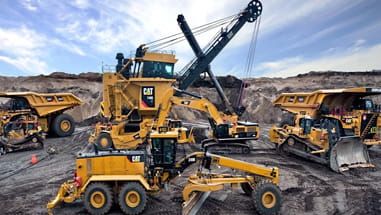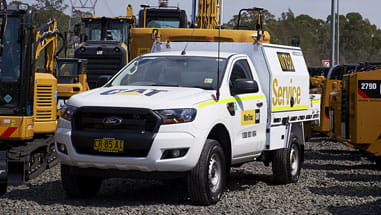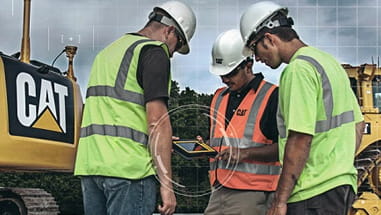With our huge inventory of new, used and rental equipment, WesTrac has the right machine for the job.
Off-Highway Trucks
Compare Models

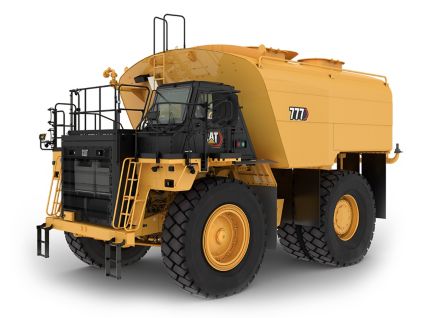
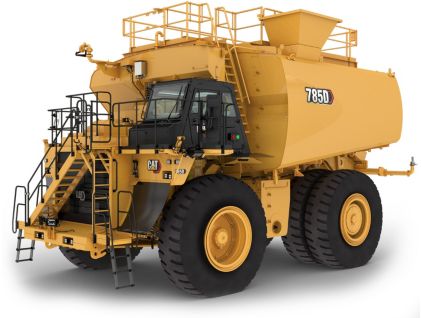
UNITS:
Metric
Imperial
Engine
Engine Model
Cat® 3516C HD
Cat® 3516C HD
Cat® C32B
Cat® C32B
Cat® 3512C HD
Cat® 3512C HD
Gross Power - SAE J1995:2014
1566 kW
2100 hp
765 kW
1026 hp
1082 kW
1450 hp
Net Power - SAE J1349:2011
1468 kW
1969 hp
711 kW
953 hp
1005 kW
1348 hp
Emissions
Fuel Optimized or EPA Tier 2 equivalent.
Fuel Optimized or EPA Tier 2 equivalent.
Fuel Optimized
Fuel Optimized
Fuel Optimized
Fuel Optimized
Bore
215 mm
6.7 in
145 mm
5.7 in
170 mm
6.7 in
Stroke
78.1 l
4766 in³
162 mm
6.4 in
215 mm
8.4 in
Displacement
58.56 l
3573.6 in³
32.1 l
1959 in³
58.56 l
3573.6 in³
Note (1)
Net Power advertised is the power available at the flywheel when the engine is equipped with fan, air cleaner, muffler, and alternator with engine speed at 1,750 rpm.
Net Power advertised is the power available at the flywheel when the engine is equipped with fan, air cleaner, muffler, and alternator with engine speed at 1,750 rpm.
Net Power advertised is the power available at the flywheel when the engine is equipped with fan, air cleaner, muffler, and alternator with engine speed at 1,800 rpm.
Net Power advertised is the power available at the flywheel when the engine is equipped with fan, air cleaner, muffler, and alternator with engine speed at 1,800 rpm.
Net Power advertised is the power available at the flywheel when
the engine is equipped with fan, air cleaner, muffler, and alternator
with engine speed at 1,800 rpm.
Net Power advertised is the power available at the flywheel when
the engine is equipped with fan, air cleaner, muffler, and alternator
with engine speed at 1,800 rpm.
Engine Speed
-
1800 r/min
1800 r/min
-
Cylinders
-
12
12
-
Note (2)
-
No engine derating required up to 3048 m (10,000 ft) altitude.
No engine derating required up to 3048 m (10,000 ft) altitude.
-
Note (3)
-
Meets China Nonroad Stage III emission standards equivalent to U.S. EPA Tier 2.
Meets China Nonroad Stage III emission standards equivalent to U.S. EPA Tier 2.
-
Cat Water Delivery System (WDS)
Maximum water flow
6814 l/min
1800 gal(US)/min
6814 l/min
1800 gal(US)/min
6814 l/min
1800 gal(US)/min
Water per spray head (minimum)
132.5 l/min
35 gal(US)/min
132.5 l/min
35 gal(US)/min
132.5 l/min
35 gal(US)/min
Water per spray head (maximum)
2271 l/min
600 gal(US)/min
2271 l/min
600 gal(US)/min
2270 l/min
600 gal(US)/min
Spray head opening range (minimum)
1 mm
0.04 in
1 mm
0.04 in
1 mm
0.04 in
Spray head opening range (maximum)
19 mm
0.75 in
19 mm
0.75 in
19 mm
0.75 in
Maximum size debris flushed through spray head
19 mm
0.75 in
19 mm
0.75 in
19 mm
0.75 in
Spray system hydraulic tank capacity
27.5 l
7.25 gal (US)
27.5 l
7.25 gal (US)
27.5 l
7.25 gal (US)
Maximum number of rear spray heads
5
5
5
5
5
5
Minimum number of rear spray heads (recommended 3)
2
2
2
2
2
2
Minimum number of front/side spray heads
2
2
2
2
2
2
Maximum number of front/side spray heads
0
0
0
0
0
0
Maximum water from cannon (idle)
2271 l/min
600 gal(US)/min
2271 l/min
600 gal(US)/min
2271 l/min
600 gal(US)/min
Maximum water from cannon (high idle)
4732 l/min
1250 gal(US)/min
6246 l/min
1650 gal(US)/min
6246 l/min
1650 gal(US)/min
Maximum cannon spray distance
61 m
200 ft
61 m
200 ft
61 m
200 ft
Type
Wet water pump/hydraulic motor coupling
Wet water pump/hydraulic motor coupling
Wet water pump/hydraulic motor coupling
Wet water pump/hydraulic motor coupling
Wet water pump/hydraulic motor coupling
Wet water pump/hydraulic motor coupling
Note
Selectable coverage: 0.1-0.8 L/m² (4 kph - 40 kph) / 0.05-0.2 gal/ft² (3 mph - 25 mph). Coverage rates above 0.6 L/m² may not be available at higher speeds depending on head count and configuration.
Selectable coverage: 0.1-0.8 L/m² (4 kph - 40 kph) / 0.05-0.2 gal/ft² (3 mph - 25 mph). Coverage rates above 0.6 L/m² may not be available at higher speeds depending on head count and configuration.
Operator selectable coverage: 0.1 - 0.8 L/m² (4 kph - 40 kph) / 0.05 - 0.2 gal/ft² (3 mph - 25 mph). Coverage rates above 0.6 L/m² may not be available at higher speeds depending on head count and configuration.
Operator selectable coverage: 0.1 - 0.8 L/m² (4 kph - 40 kph) / 0.05 - 0.2 gal/ft² (3 mph - 25 mph). Coverage rates above 0.6 L/m² may not be available at higher speeds depending on head count and configuration.
Operator selectable coverage: 0.1 - 0.8 L/m² (4 kph - 40 kph) / 0.05 - 0.2 gal/ft² (3 mph - 25 mph). Coverage rates above 0.6 L/m² may not be available at higher speeds depending on head count and configuration.
Operator selectable coverage: 0.1 - 0.8 L/m² (4 kph - 40 kph) / 0.05 - 0.2 gal/ft² (3 mph - 25 mph). Coverage rates above 0.6 L/m² may not be available at higher speeds depending on head count and configuration.
Note (1)
Spray head opening is automatically controlled by the system to achieve Auto Mode Coverage or manual mode flow rate.
Spray head opening is automatically controlled by the system to achieve Auto Mode Coverage or manual mode flow rate.
Spray head opening is automatically controlled by the system to achieve Auto Mode Coverage or manual mode flow rate.
Spray head opening is automatically controlled by the system to achieve Auto Mode Coverage or manual mode flow rate.
Spray head opening is automatically controlled by the system to achieve Auto Mode Coverage or manual mode flow rate.
Spray head opening is automatically controlled by the system to achieve Auto Mode Coverage or manual mode flow rate.
Note (2)
The Auto Mode setting controls water coverage and automatically adjusts to the number of spray heads being used — independent of ground speed. This is an exclusive feature designed into the Cat WDS software to help water more efficiently. Water flow is continually adjusted during operation to conserve water and achieve desired coverage and flow rate.
The Auto Mode setting controls water coverage and automatically adjusts to the number of spray heads being used — independent of ground speed. This is an exclusive feature designed into the Cat WDS software to help water more efficiently. Water flow is continually adjusted during operation to conserve water and achieve desired coverage and flow rate.
The Auto Mode setting controls water coverage and automatically adjusts to the number of spray heads being used — independent of ground speed. This is an exclusive feature designed into the Cat WDS software to help water more efficiently. Water flow is continually adjusted during operation to conserve water and achieve desired coverage and flow rate.
The Auto Mode setting controls water coverage and automatically adjusts to the number of spray heads being used — independent of ground speed. This is an exclusive feature designed into the Cat WDS software to help water more efficiently. Water flow is continually adjusted during operation to conserve water and achieve desired coverage and flow rate.
The Auto Mode setting controls water coverage and automatically adjusts to the number of spray heads being used — independent of ground speed. This is an exclusive feature designed into the Cat WDS software to help water more efficiently. Water flow is continually adjusted during operation to conserve water and achieve desired coverage and flow rate.
The Auto Mode setting controls water coverage and automatically adjusts to the number of spray heads being used — independent of ground speed. This is an exclusive feature designed into the Cat WDS software to help water more efficiently. Water flow is continually adjusted during operation to conserve water and achieve desired coverage and flow rate.
Note (3)
When the truck speed drops below 4.8 kph (3 mph), the system shuts off automatically to prevent overwatering, and then automatically re-starts as speed increases.
When the truck speed drops below 4.8 kph (3 mph), the system shuts off automatically to prevent overwatering, and then automatically re-starts as speed increases.
Alternatively, manual mode allows the operator to set a water flow rate that is constant regardless of ground speed. This mode is not recommended for daily operation and will reduce watering efficiency and may increase fuel usage.
Alternatively, manual mode allows the operator to set a water flow rate that is constant regardless of ground speed. This mode is not recommended for daily operation and will reduce watering efficiency and may increase fuel usage.
Alternatively, manual mode allows the operator to set a water flow rate that is constant regardless of ground speed. This mode is not recommended for daily operation and will reduce watering efficiency and may increase fuel usage.
Alternatively, manual mode allows the operator to set a water flow rate that is constant regardless of ground speed. This mode is not recommended for daily operation and will reduce watering efficiency and may increase fuel usage.
Note (4)
Spray heads on competitive water distribution systems require tools and maintenance to change flow and spray pattern. Caterpillar is the only company to have variable active spray heads to regulate water spray.
Spray heads on competitive water distribution systems require tools and maintenance to change flow and spray pattern. Caterpillar is the only company to have variable active spray heads to regulate water spray.
Spray heads on competitive water distribution systems require tools and maintenance to change flow and spray pattern. Caterpillar is the only company to have variable active spray heads to regulate water spray.
Spray heads on competitive water distribution systems require tools and maintenance to change flow and spray pattern. Caterpillar is the only company to have variable active spray heads to regulate water spray.
Spray heads on competitive water distribution systems require tools and maintenance to change flow and spray pattern. Caterpillar is the only company to have variable active spray heads to regulate water spray.
Spray heads on competitive water distribution systems require tools and maintenance to change flow and spray pattern. Caterpillar is the only company to have variable active spray heads to regulate water spray.
Note (5)
Cannon performance depends on nozzle orifice and pipe size. Cannon mode may only be operated manually. Not available for autonomous operation.
Cannon performance depends on nozzle orifice and pipe size. Cannon mode may only be operated manually. Not available for autonomous operation.
Cannon performance depends on nozzle orifice and pipe size.
Cannon performance depends on nozzle orifice and pipe size.
Cannon performance depends on nozzle orifice and pipe size.
Cannon performance depends on nozzle orifice and pipe size.
Tank Configurations
Water Tank Capacity
up to 155 000 L (41,000 gal)
up to 155 000 L (41,000 gal)
up to 75 700 L (20,000 gal)
up to 75 700 L (20,000 gal)
up to 121 133 L (32,000 gal)
up to 121 133 L (32,000 gal)
Note
Water Tank Capacity Range: 151 416 L - 155 000 L (40,000 gal - 41,000 gal)
Water Tank Capacity Range: 151 416 L - 155 000 L (40,000 gal - 41,000 gal)
Multiple tank configurations are offered based on customer preference and regional locations. Water Tank Capacity Range: 75 400 - 75 700 L (19,900 - 20,000 gal)
Multiple tank configurations are offered based on customer preference and regional locations. Water Tank Capacity Range: 75 400 - 75 700 L (19,900 - 20,000 gal)
Multiple tank configurations are offered based on customer preference and regional locations. Water Tank Capacity Range: 110 000 - 121 133 L (29,059 - 32,000 gal)
Multiple tank configurations are offered based on customer preference and regional locations. Water Tank Capacity Range: 110 000 - 121 133 L (29,059 - 32,000 gal)
Machine Weight (with water tank full)
641,774 lb - 656,103 lb / 291 105 kg - 297 393 kg
641,774 lb - 656,103 lb / 291 105 kg - 297 393 kg
315,365 - 327,964 lb / 143 047 - 148 762 kg
315,365 - 327,964 lb / 143 047 - 148 762 kg
480,655 lb - 520,237 lb / 218 022 kg - 235 976 kg
480,655 lb - 520,237 lb / 218 022 kg - 235 976 kg
Empty Machine Operating Weight (without water / with fuel)
308,619 lb - 314,619 lb / 139 988 kg - 142 700 kg
308,619 lb - 314,619 lb / 139 988 kg - 142 700 kg
151,204 - 153,221 lb / 68 585 - 69 500 kg
151,204 - 153,221 lb / 68 585 - 69 500 kg
241,647 lb - 251,098 lb / 109 610 kg - 113 896 kg
241,647 lb - 251,098 lb / 109 610 kg - 113 896 kg
Water Tank - Max Empty Weight (no WDS)
80,000 lb - 86,000 lb / 36 288 kg - 39 000 kg
80,000 lb - 86,000 lb / 36 288 kg - 39 000 kg
42,983 - 44,092 lb / 19 497 - 20 000 kg
42,983 - 44,092 lb / 19 497 - 20 000 kg
57,320 lb - 66,769 lb / 26 000 kg - 30 286 kg
57,320 lb - 66,769 lb / 26 000 kg - 30 286 kg
Note (1)
Please contact your Cat dealer, Mining Tech Rep or the Mining Technology Enable Solutions team (MTES) for requirements on the autonomous water truck. They will also be able to provide a list of the approved water tank manufacturers for the 789D autonomous water truck configuration.
Please contact your Cat dealer, Mining Tech Rep or the Mining Technology Enable Solutions team (MTES) for requirements on the autonomous water truck. They will also be able to provide a list of the approved water tank manufacturers for the 789D autonomous water truck configuration.
Cat branded tanks include additional features and options commonly selected by customers in the industry. Splash guards, fill chute, and rock ejectors are standard.
Cat branded tanks include additional features and options commonly selected by customers in the industry. Splash guards, fill chute, and rock ejectors are standard.
Cat branded tanks include additional features and options commonly selected by customers in the industry. Splash guards, fill chute, and rock ejectors are standard.
Cat branded tanks include additional features and options commonly selected by customers in the industry. Splash guards, fill chute, and rock ejectors are standard.
Note (2)
Hoist cylinder mounting on all tank offerings enhances serviceability.
Hoist cylinder mounting on all tank offerings enhances serviceability.
Hoist cylinder mounting on all tank offerings enhances serviceability.
Hoist cylinder mounting on all tank offerings enhances serviceability.
Hoist cylinder mounting on all tank offerings enhances serviceability.
Hoist cylinder mounting on all tank offerings enhances serviceability.
Operating Specifications
Note
Water Tank Capacity Range: 151 416 L - 155 000 L (40,000 gal - 41,000 gal)
Water Tank Capacity Range: 151 416 L - 155 000 L (40,000 gal - 41,000 gal)
Water Tank Capacity Range: 69 700 - 75 700 L (18,400 - 20,000 gal)
Water Tank Capacity Range: 69 700 - 75 700 L (18,400 - 20,000 gal)
Water Tank Capacity Range: 110 000 - 121 133 L (29,059 - 32,000 gal)
Water Tank Capacity Range: 110 000 - 121 133 L (29,059 - 32,000 gal)
Note (2)
Operator selectable coverage: 0.2-0.8 L/m² (4 kph - 40 kph) / 0.5-0.2 gal/ft² (3 mph - 25 mph)
Operator selectable coverage: 0.2-0.8 L/m² (4 kph - 40 kph) / 0.5-0.2 gal/ft² (3 mph - 25 mph)
Operator selectable coverage: 0.2-0.8 L/m² (4 kph - 40 kph) / 0.5-0.2 gal/ft² (3 mph - 25 mph)
Operator selectable coverage: 0.2-0.8 L/m² (4 kph - 40 kph) / 0.5-0.2 gal/ft² (3 mph - 25 mph)
Operator selectable coverage: 0.2-0.8 L/m² (4 kph - 40 kph) / 0.5-0.2 gal/ft² (3 mph - 25 mph)
Operator selectable coverage: 0.2-0.8 L/m² (4 kph - 40 kph) / 0.5-0.2 gal/ft² (3 mph - 25 mph)
Top Speed - Loaded
-
67.1 km/h
41.7 mile/h
-
Weights - Approximate
Target Gross Machine Weight
324319 kg
715000 lb
163360 kg
360148 lb
249476 kg
550000 lb
Chassis Weight
103700 kg
228619 lb
82022 kg
180827 lb
82022 kg
180827 lb
Transmission
Forward - 1
12.6 km/h
7.8 mile/h
10.9 km/h
6.8 mile/h
12.1 km/h
7.5 mile/h
Forward - 2
17.1 km/h
10.6 mile/h
14.8 km/h
9.2 mile/h
16.3 km/h
10.2 mile/h
Forward - 3
23.1 km/h
14.4 mile/h
20.1 km/h
12.6 mile/h
22.2 km/h
13.8 mile/h
Forward - 4
31.2 km/h
19.4 mile/h
27.1 km/h
16.9 mile/h
29.9 km/h
18.6 mile/h
Forward - 5
42.3 km/h
26.3 mile/h
36.8 km/h
22.9 mile/h
40.6 km/h
25.2 mile/h
Forward - 6
57.2 km/h
35.5 mile/h
49.4 km/h
30.7 mile/h
54.8 km/h
34 mile/h
Reverse
11.8 km/h
7.3 mile/h
12.1 km/h
7.5 mile/h
11 km/h
6.8 mile/h
Note
Maximum travel speeds with standard 37.00-R57 tires.
Maximum travel speeds with standard 37.00-R57 tires.
Maximum travel speeds with standard 27.00R49 (E4) tires.
Maximum travel speeds with standard 27.00R49 (E4) tires.
Maximum travel speeds with standard 33.00-R51 tires.
Maximum travel speeds with standard 33.00-R51 tires.
Forward - 7
-
67.1 km/h
41.7 mile/h
-
Final Drives
Differential Ratio
2.35:1
2.35:1
2.74:1
2.74:1
2.10:1
2.10:1
Planetary Ratio
10.83:1
10.83:1
7.00:1
7.00:1
10.83:1
10.83:1
Total Reduction Ratio
25.46:1
25.46:1
19.16:1
19.16:1
22.75:1
22.75:1
Braking System
Brake Surface - Front
81693 cm²
12662 in²
2787 cm²
432 in²
61270 cm²
9497 in²
Brake Surface - Rear
134590 cm²
20862 in²
102116 cm²
15828 in²
89729 cm²
13908 in²
Brake Standards
ISO 3450:2011
ISO 3450:2011
ISO 3450:2011
ISO 3450:2011
ISO 3450:2011
ISO 3450:2011
Body Hoists
Pump Flow - High Idle
731 l/min
193 gal/min
-
750 l/min
198 gal/min
Relief Valve Setting - Raise
17238 kPa
2500 psi
-
17238 kPa
2500 psi
Body Raise Time - High Idle
18.9 s
18.9 s
15 s
15 s
15.2 s
15.2 s
Body Lower Time - Float
17.3 s
17.3 s
13 s
13 s
16.2 s
16.2 s
Body Lower Time - High Idle
15.6 s
15.6 s
13 s
13 s
15.9 s
15.9 s
Relief Valve Setting - Lower
-
-
3450 kPa
500 psi
Weight Distributions - Approximate
Front Axle - Empty
46 %
46 %
46 %
46 %
46 %
46 %
Front Axle - Loaded
33 %
33 %
30 %
30 %
33 %
33 %
Rear Axle - Empty
54 %
54 %
54 %
54 %
54 %
54 %
Rear Axle - Loaded
67 %
67 %
70 %
70 %
67 %
67 %
Suspension
Rear axle - Oscillation
5.6 °
5.6 °
5.4 °
5.4 °
5 °
5 °
Effective Cylinder Stroke - Front
-
318 mm
12.5 in
-
Effective Cylinder Stroke - Rear
-
165 mm
6.5 in
-
Steering
Steering Standards
ISO 5010:2019
ISO 5010:2019
ISO 5010:2007
ISO 5010:2007
ISO 5010:2007
ISO 5010:2007
Steer Angle
36 °
36 °
30.5 °
30.5 °
36 °
36 °
Turning Diameter - Front
27.53 m
90.32 ft
25.3 m
83 ft
29.8 m
97.7 ft
Turning Circle - Clearance Diameter
-
28.4 m
93.2 ft
-
Tires
Standard Tire
37.00-R57
37.00-R57
27.00R49 (E4)
27.00R49 (E4)
33.00-R51 (E3 & E4)
33.00-R51 (E3 & E4)
Note (1)
Optional tire: 40.00-R57
Optional tire: 40.00-R57
Productive capabilities of the 777 truck are such that, under certain job conditions, TKPH (TMPH) capabilities of standard or optional tires could be exceeded and, therefore, limit production.
Productive capabilities of the 777 truck are such that, under certain job conditions, TKPH (TMPH) capabilities of standard or optional tires could be exceeded and, therefore, limit production.
Productive capabilities of the 785D truck are such that, under certain job conditions, TKPH (TMPH) capabilities of standard or optional tires could be exceeded and, therefore, limit production.
Productive capabilities of the 785D truck are such that, under certain job conditions, TKPH (TMPH) capabilities of standard or optional tires could be exceeded and, therefore, limit production.
Note (2)
Caterpillar recommends the customer evaluate all job conditions and consult the tire manufacturer for proper tire selection.
Caterpillar recommends the customer evaluate all job conditions and consult the tire manufacturer for proper tire selection.
Caterpillar recommends the customer evaluate all job conditions and consult the tire manufacturer for proper tire selection.
Caterpillar recommends the customer evaluate all job conditions and consult the tire manufacturer for proper tire selection.
Caterpillar recommends the customer evaluate all job conditions and consult the tire manufacturer for proper tire selection.
Caterpillar recommends the customer evaluate all job conditions and consult the tire manufacturer for proper tire selection.
Service Refill Capacities
Fuel Tank
2082 l
550 gal (US)
-
1893 l
500 gal (US)
Cooling System
725 l
192 gal (US)
212 l
56 gal (US)
379 l
100 gal (US)
Crankcase
291 l
77 gal (US)
115 l
30 gal (US)
204 l
54 gal (US)
Differential - Final Drives
583 l
154 gal (US)
-
436 l
115 gal (US)
Steering System - Including Tank
189 l
50 gal (US)
60 l
16 gal (US)
117 l
31 gal (US)
Brake Hoist System
909 l
241 gal (US)
420 l
110 gal (US)
337 l
89 gal (US)
Fuel Tank (1)
-
1140 l
300 gal (US)
-
Differentials
-
222 l
59 gal (US)
-
Torque Converter - Transmission System
-
125 l
33 gal (US)
-
Steering Tank
-
-
90 l
24 gal (US)
Brake Hoist System - Includes Tank
-
-
641 l
169 gal (US)
Torque Converter - Transmission System - Including Sump
-
-
248 l
65.5 gal (US)
Cab
Air Conditioning
42780 Btu/kWh
18390 Btu/lb
42789 Btu/kWh
18390 Btu/lb
42780 Btu/kWh
18390 Btu/lb
Heater / Defroster
11070 kJ/kg
43930 Btu
11070 kJ/kg
43930 Btu
11070 kJ/kg
43930 Btu
ROPS Standards (1)
ROPS (Rollover Protective Structure) for cab offered by Caterpillar meets ISO 3471:2008 ROPS criteria and ISO 13459:2012 for trainer.
ROPS (Rollover Protective Structure) for cab offered by Caterpillar meets ISO 3471:2008 ROPS criteria and ISO 13459:2012 for trainer.
Rollover protective structure (ROPS) cab offered by Caterpillar meets ISO 3471:2008 for operator and ISO 13459:2012 for trainer.
Rollover protective structure (ROPS) cab offered by Caterpillar meets ISO 3471:2008 for operator and ISO 13459:2012 for trainer.
The ROPS (Rollover Protective Structure) for the cab offered by Caterpillar meets ISO 3471:2008 ROPS criteria.
The ROPS (Rollover Protective Structure) for the cab offered by Caterpillar meets ISO 3471:2008 ROPS criteria.
FOPS Standards
FOPS (Falling Objects Protective Structure) meets ISO 3449:2005 Level II FOPS criteria and ISO 13459:2012 Level II for trainer.
FOPS (Falling Objects Protective Structure) meets ISO 3449:2005 Level II FOPS criteria and ISO 13459:2012 Level II for trainer.
Falling objects protective structure (FOPS) meets ISO 3449:2005 Level II for operator and ISO 13459:2012 Level II FOPS for trainer.
Falling objects protective structure (FOPS) meets ISO 3449:2005 Level II for operator and ISO 13459:2012 Level II FOPS for trainer.
The FOPS (Falling Objects Protective Structure) meets ISO 3449:2005 Level II FOPS criteria.
The FOPS (Falling Objects Protective Structure) meets ISO 3449:2005 Level II FOPS criteria.
Note (1)
The operator sound exposure Leq (equivalent sound pressure level) measured according to work cycle procedures specified in ANSI/SAE J1166 MAY90 is 80 dB(A) for cab offered by Caterpillar, when properly installed, maintained and tested with doors and windows closed.
The operator sound exposure Leq (equivalent sound pressure level) measured according to work cycle procedures specified in ANSI/SAE J1166 MAY90 is 80 dB(A) for cab offered by Caterpillar, when properly installed, maintained and tested with doors and windows closed.
The dynamic operator sound pressure level is 80 dB(A) as per ISO 6396:2008 for cab offered by Caterpillar. The cab was properly installed and maintained. The test was conducted with the cab doors and the cab windows closed.
The dynamic operator sound pressure level is 80 dB(A) as per ISO 6396:2008 for cab offered by Caterpillar. The cab was properly installed and maintained. The test was conducted with the cab doors and the cab windows closed.
The operator sound exposure Leq (equivalent sound pressure level) measured according to work cycle procedures specified in ANSI/SAE J1166 MAY90 is 80 dB(A) for cab offered by Caterpillar, when properly installed, maintained and tested with doors and windows closed.
The operator sound exposure Leq (equivalent sound pressure level) measured according to work cycle procedures specified in ANSI/SAE J1166 MAY90 is 80 dB(A) for cab offered by Caterpillar, when properly installed, maintained and tested with doors and windows closed.
Note (2)
The exterior sound power level for the standard machine is tested using ISO 6393:2008 and ISO 6395:2008 procedures is 123 dB(A).
The exterior sound power level for the standard machine is tested using ISO 6393:2008 and ISO 6395:2008 procedures is 123 dB(A).
-
The exterior sound pressure level for the standard machine measured at a distance of 15 m (49 ft) according to the test procedures specified in SAE J88 APR95, mid-gear moving operation is 89 dB(A).
The exterior sound pressure level for the standard machine measured at a distance of 15 m (49 ft) according to the test procedures specified in SAE J88 APR95, mid-gear moving operation is 89 dB(A).
Note (3)
Hearing protection may be needed when operating with an open operator station and cab (when not properly maintained or doors/windows open) for extended periods or in a noisy environment.
Hearing protection may be needed when operating with an open operator station and cab (when not properly maintained or doors/windows open) for extended periods or in a noisy environment.
-
Hearing protection may be needed when operating with an open operator station and cab (when not properly maintained or doors/windows open) for extended periods or in a noisy environment.
Hearing protection may be needed when operating with an open operator station and cab (when not properly maintained or doors/windows open) for extended periods or in a noisy environment.

